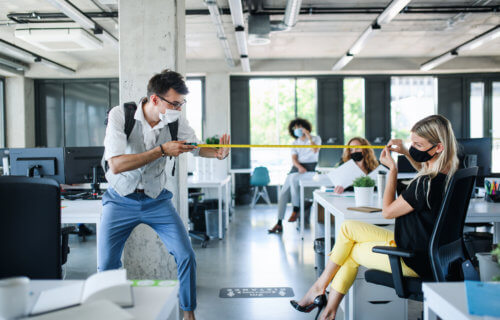UNIVERSITY PARK, Pa. — Social distancing and remaining six feet away from other people isn’t enough to stop the spread of viral airborne aerosols (like COVID-19) while indoors, researchers from Penn State warn. The “six-foot rule” has been a general safety recommendation throughout the pandemic. However, this study concludes even six and a half feet may not be far enough to prevent infection inside a building.
“We set out to explore the airborne transport of virus-laden particles released from infected people in buildings,” says first study author Gen Pei, doctoral student in architectural engineering at Penn State, in a university release. “We investigated the effects of building ventilation and physical distancing as control strategies for indoor exposure to airborne viruses.”
Talking can spread COVID quickly
The research team focused primarily on three factors during this project: The amount and rate of air ventilated through an indoor area, the indoor airflow pattern associated with different ventilation strategies, and the aerosol emission mode of breathing as opposed to talking. The team also compared tracer gas, which scientists use to detect leaks in air-tight systems, to human respiratory aerosols of various sizes ranging from one to 10 micrometers. Importantly, aerosols of those sizes can carry SARS-CoV-2.
“Our study results reveal that virus-laden particles from an infected person’s talking — without a mask — can quickly travel to another person’s breathing zone within one minute, even with a distance of two meters,” explains corresponding study author Donghyun Rim, associate professor of architectural engineering. “This trend is pronounced in rooms without sufficient ventilation. The results suggest that physical distance alone is not enough to prevent human exposure to exhaled aerosols and should be implemented with other control strategies such as masking and adequate ventilation.”
Staying at home may be worse for spreading COVID
Study authors report aerosols tend to travel further and faster indoors in rooms with displacement ventilation. This means fresh air is constantly flowing up from the floor and pushing old air to an exhaust vent near the ceiling. Unfortunately, most residential homes feature displacement ventilation.
In comparison to a mixed-mode ventilation system, displacement ventilation can result in the inhalation of seven times more viral aerosols. On a more positive note, many commercial buildings use a mixed-mode ventilation system, which means some outside air mixes into the indoor environment.
“This is one of the surprising results: Airborne infection probability could be much higher for residential environments than office environments,” Prof. Rim adds. “However, in residential environments, operating mechanical fans and stand-alone air cleaners can help reduce infection probability.”
Researchers say increasing both ventilation and air mixing rates can help stop the spread of viral aerosols indoors. While taking those measures is a good start, it’s still a good idea to incorporate further protection strategies such as using a face mask.
“Airborne infection control strategies such as physical distancing, ventilation and mask wearing should be considered together for a layered control,” Prof. Rim concludes.
The study appears in the journal Sustainable Cities and Society.
